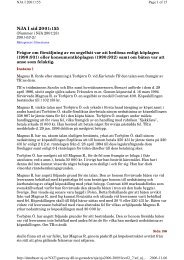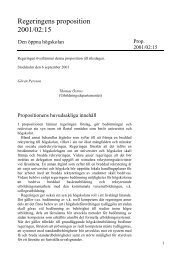A Study of the ITU-T G.729 Speech Coding Algorithm ...
A Study of the ITU-T G.729 Speech Coding Algorithm ...
A Study of the ITU-T G.729 Speech Coding Algorithm ...
Create successful ePaper yourself
Turn your PDF publications into a flip-book with our unique Google optimized e-Paper software.
Open<br />
MASTER THESIS<br />
5 Overview <strong>of</strong> <strong>the</strong> Flexible ASIC Concept<br />
5.1 Introduction<br />
Datum - Date Rev Dokumentnr - Document no.<br />
04-09-28 PA1<br />
Flexible ASIC, a System-on-Chip architecture, enables <strong>the</strong> implementation <strong>of</strong> digital signal<br />
processing functions and is a concept developed for <strong>the</strong> design <strong>of</strong> small, cost efficient and<br />
high performance solutions whose essential characteristic is a high degree <strong>of</strong> reprogramming<br />
flexibility. The integration <strong>of</strong> DSP cores on a single ASIC chip forms hereby <strong>the</strong> basis<br />
<strong>of</strong> <strong>the</strong> flexible ASIC.<br />
In order to guarantee an even higher degree <strong>of</strong> flexibility, a library <strong>of</strong> processor core<br />
building blocks, from which a customized processor core can be assembled, exists. A set<br />
<strong>of</strong> DSP s<strong>of</strong>tware development tools, which enable <strong>the</strong> programming <strong>of</strong> <strong>the</strong> processor, are<br />
supported by <strong>the</strong> Flexible ASIC concept. The concept, which is promoted by <strong>the</strong> Ericsson<br />
Technology Board, has been used in real projects since 1996 [9].<br />
5.2 Background<br />
Modern digital communication systems place high demands on digital signal processing.<br />
Today, a system’s manufacturing cost and power dissipation largely stem from different<br />
Digital Signal Processors (DSPs), which explains why optimizing both, <strong>the</strong> s<strong>of</strong>tware and<br />
hardware implementation <strong>of</strong> digital signal processing, has become increasingly important.<br />
Additional aspects which have to be considered in <strong>the</strong> decision <strong>of</strong> a suitable DSP are, for<br />
instance, <strong>the</strong> DSP instruction set, clock frequency, chip size, <strong>the</strong> memory capacity <strong>of</strong> data<br />
and program memories, <strong>the</strong> respective s<strong>of</strong>tware development tools as well as <strong>the</strong> efficiency<br />
<strong>of</strong> <strong>the</strong> C-compiler, in <strong>the</strong> case algorithms are intended to be written in C.<br />
However, even if a DSP is clocked at a high frequency, it does not necessarily perform<br />
a particular algorithm faster compared to a DSP with a lower clock frequency. In some<br />
cases, <strong>the</strong> instruction set in <strong>the</strong> slower DSP might suit <strong>the</strong> algorithm, which is to be implemented,<br />
better. Since an increase in <strong>the</strong> performance is related with increases in <strong>the</strong><br />
number <strong>of</strong> instructions which can be executed within a clock cycle, <strong>the</strong> parallelism <strong>of</strong> <strong>the</strong><br />
DSP represents an essential aspect as well.<br />
The most essential algorithms require <strong>the</strong> direct implementation in dedicated logic, as<br />
a consequence <strong>of</strong> speed requirements, in a Field Programmable Gate Array (FPGA) or<br />
an Application Specific Integrated Circuit (ASIC). Since <strong>the</strong> FPGA <strong>of</strong>fers <strong>the</strong> possibility <strong>of</strong><br />
being reprogrammed in case <strong>the</strong> functionality <strong>of</strong> <strong>the</strong> algorithm has to be changed, it guarantees<br />
a high degree <strong>of</strong> flexibility. However, <strong>the</strong> large costs and size, essentially eliminate <strong>the</strong><br />
use <strong>of</strong> FPGAs. In contrast to <strong>the</strong> FPGA, ASIC delivers generally very good performance<br />
as well as a small circuit area. An ASIC <strong>of</strong>fers however no flexibility since its functionality<br />
cannot be changed once it is manufactured [19].<br />
5.3 ASIC and DSP<br />
Today, <strong>the</strong> majority <strong>of</strong> projects requires <strong>the</strong> possibility to change and update <strong>the</strong> functionality<br />
<strong>of</strong> a signal processing system. However, if DSPs would be used only, performance<br />
requirements could not be met. One solution would be to combine <strong>the</strong> advantages <strong>of</strong> an<br />
ASIC with <strong>the</strong> flexibility <strong>of</strong> <strong>the</strong> DSP. Figure 20 depicts a comparison <strong>of</strong> different technolo-<br />
46 (78)





